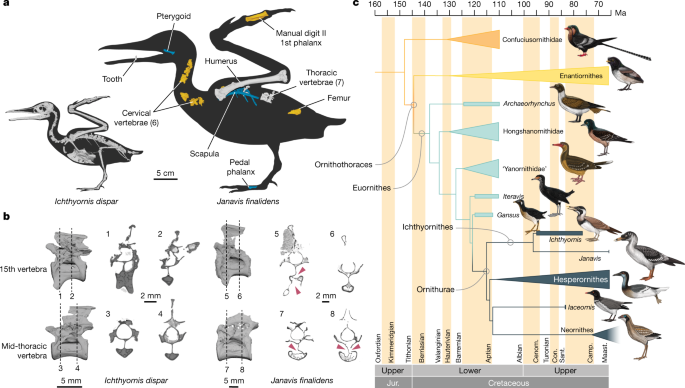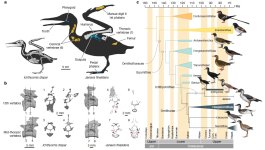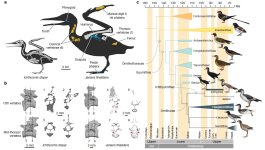Fred Ruhe
Well-known member

Juan Benito, Pei Chen Kuo, Klara E. Widrig, John W. M. Jagt. Daniel J. Field, 2022
Cretaceous ornithurine supports a neognathous crown bird ancestor
Nature. 612 (7938): 100–105
doi:10.1038/s41586-022-05445-y
Abstract:

 www.nature.com
www.nature.com
The bony palate diagnoses the two deepest clades of extant birds: Neognathae and Palaeognathae1,2,3,4,5. Neognaths exhibit unfused palate bones and generally kinetic skulls, whereas palaeognaths possess comparatively rigid skulls with the pterygoid and palatine fused into a single element, a condition long considered ancestral for crown birds (Neornithes)3,5,6,7,8. However, fossil evidence of palatal remains from taxa close to the origin of Neornithes is scarce, hindering strong inferences regarding the ancestral condition of the neornithine palate. Here we report a new taxon of toothed Late Cretaceous ornithurine bearing a pterygoid that is remarkably similar to those of the extant neognath clade Galloanserae (waterfowl + landfowl). Janavis finalidens, gen. et sp. nov., is generally similar to the well-known Mesozoic ornithurine Ichthyornis in its overall morphology, although Janavis is much larger and exhibits a substantially greater degree of postcranial pneumaticity. We recovered Janavis as the first-known well-represented member of Ichthyornithes other than Ichthyornis, clearly substantiating the persistence of the clade into the latest Cretaceous9. Janavis confirms the presence of an anatomically neognathous palate in at least some Mesozoic non-crown ornithurines10,11,12, suggesting that pterygoids similar to those of extant Galloanserae may be plesiomorphic for crown birds. Our results, combined with recent evidence on the ichthyornithine palatine12, overturn longstanding assumptions about the ancestral crown bird palate, and should prompt reevaluation of the purported galloanseran affinities of several bizarre early Cenozoic groups such as the ‘pseudotoothed birds’ (Pelagornithidae)
Enjoy,
Fred
Cretaceous ornithurine supports a neognathous crown bird ancestor
Nature. 612 (7938): 100–105
doi:10.1038/s41586-022-05445-y
Abstract:

Cretaceous ornithurine supports a neognathous crown bird ancestor - Nature
A new taxon of toothed Late Cretaceous ornithurine preserving a pterygoid is reported, overturning assumptions about the nature of the ancestral crown bird skull.
The bony palate diagnoses the two deepest clades of extant birds: Neognathae and Palaeognathae1,2,3,4,5. Neognaths exhibit unfused palate bones and generally kinetic skulls, whereas palaeognaths possess comparatively rigid skulls with the pterygoid and palatine fused into a single element, a condition long considered ancestral for crown birds (Neornithes)3,5,6,7,8. However, fossil evidence of palatal remains from taxa close to the origin of Neornithes is scarce, hindering strong inferences regarding the ancestral condition of the neornithine palate. Here we report a new taxon of toothed Late Cretaceous ornithurine bearing a pterygoid that is remarkably similar to those of the extant neognath clade Galloanserae (waterfowl + landfowl). Janavis finalidens, gen. et sp. nov., is generally similar to the well-known Mesozoic ornithurine Ichthyornis in its overall morphology, although Janavis is much larger and exhibits a substantially greater degree of postcranial pneumaticity. We recovered Janavis as the first-known well-represented member of Ichthyornithes other than Ichthyornis, clearly substantiating the persistence of the clade into the latest Cretaceous9. Janavis confirms the presence of an anatomically neognathous palate in at least some Mesozoic non-crown ornithurines10,11,12, suggesting that pterygoids similar to those of extant Galloanserae may be plesiomorphic for crown birds. Our results, combined with recent evidence on the ichthyornithine palatine12, overturn longstanding assumptions about the ancestral crown bird palate, and should prompt reevaluation of the purported galloanseran affinities of several bizarre early Cenozoic groups such as the ‘pseudotoothed birds’ (Pelagornithidae)
Enjoy,
Fred
Last edited:





